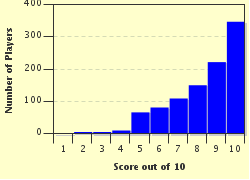Quiz Answer Key and Fun Facts
1. Like any day, Ivan Yaklovevich tears into a piece of his morning bread. This morning, though, he is repulsed to find a human nose sitting in it. The nose belongs to Major Kovalyov, who spends the remainder of the short story trying to get his nose back, even though it is impersonating a high-ranking member of the Russian society.
The events described above transpire in "The Nose," a short story by which Russian satirist of "The Overcoat" and "Dead Souls"?
2. In a certain 1859 novel, Monsieur Defarge describes John Barsad in the following manner: "...nose aquiline, but not straight, having a peculiar inclination towards the left cheek; expression, therefore, sinister." Madame Defarge is evidently satisfied with that description, with its symbolic political affiliation.
Physical descriptions of the Marquis Evremonde's nose also abound in that same novel. Which book featuring Charles Darnay and Lucie Manette is it?
3. The bigger your nose, the smarter you are, according to a certain French wit, in his best-known work. In that series of novels, the land of Ennasin is inhabited by men with club-shaped noses, which confounds one of the title giants. Who is this French author, who published "Gargantua and Pantagruel" under the pseudonym "Alcofribas Nasier"?
4. One author wasn't particularly coy about what's a symbol and what's not: in his short story "De Daumier Smith's Blue Period," he wrote: "...as I was coming in to the Avenue Victor Hugo, which is a street in Paris, I bumped into a chap without any nose. I ask you to please consider that factor, in fact I beg you. It is quite pregnant with meaning."
"De Daumier Smith's Blue Period" appears in "Nine Stories," a collection written by an author who also used the symbols of a red hunting hat and Central Park ducks in his best-known novel. Who was this American novelist and creator of the character Holden Caulfield?
5. Not Rudolph, but a man named Bardolph has an amusingly bright red nose in the play "Henry IV, Part 2." That play features the characters of Mistress Quickly and Falstaff, and it appears third in a series of four plays of British history. Who wrote that historical drama about Henry IV?
6. A good, strong nose is vital to the success of any young man coming into the world, claims the father of one novel's title character. Unfortunately, Dr. Slop crushed his son's nose with a forceps at birth, which is only fixed with some cotton and whalebone from a maid's corset. Not a great way to come into the world! Later, this novel's title character is circumcised by a window sash. Which humorous, ridiculous 1759-1767 novel by Laurence Sterne is it?
7. Saleem Sinai is tortured for a huge nose that never stops running, which grants him an unnaturally-good sense of smell. That's not his main ability, though; he also can telepathically link together with dozens of children, all born near the stroke of midnight on August 15, 1947.
Saleem is the protagonist of "Midnight's Children," a work of which British-Indian novelist who has gained controversy for his other work?
8. Seeing two random clerks while walking the streets of St. Petersburg, Svidrigailov is astonished "by the fact that they both had crooked noses, one bent to the left and the other to the right." He later claims to be going to America, before committing suicide on a bridge in Part VI of the novel in which he appears.
In what book, in which Svidrigailov serves as a manifestation of Raskolnikov's "Napoleon complex", do those strangely-depicted noses play a minor role?
9. The protagonist of one 1897 drama is witty, brave, and talented; however, he cannot marry the woman he loves because his nose is unnaturally large. Instead, Roxane marries Christian with the title character's help. Which play by Edmond Rostand is it?
10. The Fox and the Cat attack this character and attempt to hang him from a tree, but he escapes to the city of Catchfools. He eventually grows donkey ears, is helped by the Fairy with Turquoise Hair, and is reunited with Gepetto at the end of the "adventures" in which he appears.
A talking block of wood is the source of which character created by Carlo Collodi, also notable for his nose?
Source: Author
adams627
This quiz was reviewed by FunTrivia editor
looney_tunes before going online.
Any errors found in FunTrivia content are routinely corrected through our feedback system.

